Dry Eye Disease: Evaluations
Dry Eye Disease, also known as Dry Eye Syndrome or Keratoconjunctivitis Sicca, is a clinical diagnosis determined by your eye doctor. Since there are many possible factors or underlying causes, a complete health history and thorough eye examination are necessary to properly diagnose and treat dry eye conditions. Your eye doctor may have you complete a symptom questionnaire throughout Dry Eye Management in order to assess the effectiveness of the current treatment, or adjust as needed.
There are a variety of tests your eye doctor may perform to measure the severity of dry eye you are experiencing. At Eyes For Life, your doctor may choose one or more of the following evaluations:
- LipiScan™
- Meibomian Gland Evaluator™
- SPEED™ Questionnaire
- InflammaDry
- TearLab™ Osmolarity
- Tear Breakup Time
- Epithelial Staining
- The Schirmer Test
- The Phenol Red Thread Test
LipiScan™:
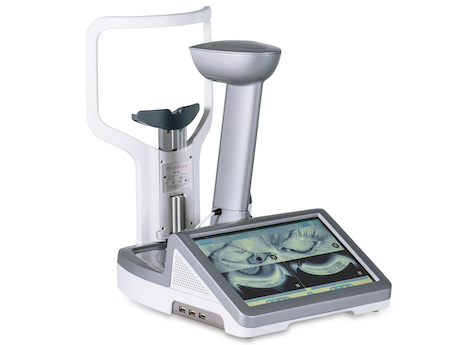
LipiScan™ Dynamic Meibomian Imager (DMI) is an ophthalmic imaging device intended for use by a physician in adult patients to capture images of the meibomian glands.
Meibomian Gland Evaluator™:
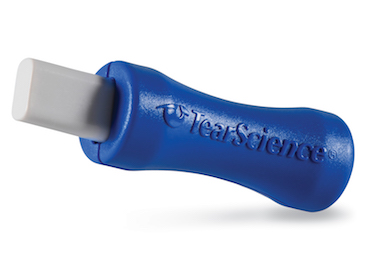
Meibomian Gland Evaluator™ (MGE) is the only instrument that provides a standardized, repeatable evaluation of meibomian gland function by applying the pressure of a deliberate blink while observing gland function through a slit lamp. The MGE™ allows your eye doctor to determine gland function, track progression and treatment response.
SPEED™ Questionnaire:
Validated by independent researchers, the Standard Patient Evaluation of Eye Dryness (SPEED™) Questionnaire identifies and rates dry eye symptoms by asking four simple questions on symptom frequency and severity. If symptoms are detected, LipiScan® and a gland evaluation are recommended.
Click to download and/or print the SPEED Questionnaire.
InflammaDry:
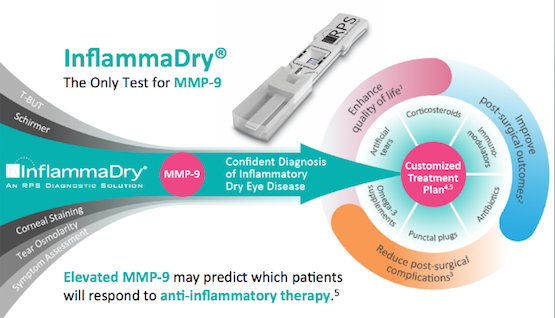
InflammaDry is a diagnostic test that is performed in office to test your tears for the presence of a molecule called MMP-9 that causes inflammation on the eye. Inflammation is associated in a vicious cycle with dry eye disease and can lead to a chronic and progressive condition. If left untreated, inflammation can cause damage to the cells on the surface of your eye and interfere with your vision.
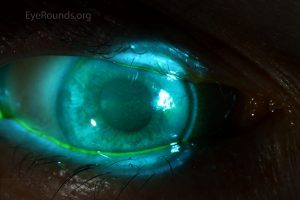
eyerounds.org
Epithelial Staining:
Epithelial Staining involves the use of special quick acting, temporary dyes. With them, your eye doctor will examine the condition of the surface of your eyes, looking for staining patterns on the cornea and conjunctiva. The most common dyes are rose bengal, lissamine green and fluorescein. The individual dyes will stain the eyes differently. For example, fluorescein will pool in epithelial erosions and stain devitalized cells. Rose bengal will also stain dead and dying cells, in addition to the cells that are healthy but are not adequately coated by a mucin layer. Rose bengal can cause some discomfort, however. Lissamine green is similar to rose bengal, but without the discomfort. Your doctor will select the dye(s) most effective for your examination.
The Schirmer Test:
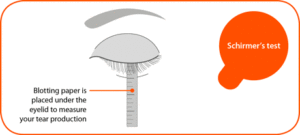 The Schirmer Test is another common test to assess for dry eye. Also known as a basal secretion test, it measures aqueous tear production. To perform this test, your eye doctor will place blotting strips, small paper strips with measurement lines, just inside the lower eyelid of each eye and have you gently close your eyes. Moisture will move down the paper strip to determine your tear production level. This timed test generally takes about 5 minutes, and a reading of 10 mm of moisture is considered normal tear production.
The Schirmer Test is another common test to assess for dry eye. Also known as a basal secretion test, it measures aqueous tear production. To perform this test, your eye doctor will place blotting strips, small paper strips with measurement lines, just inside the lower eyelid of each eye and have you gently close your eyes. Moisture will move down the paper strip to determine your tear production level. This timed test generally takes about 5 minutes, and a reading of 10 mm of moisture is considered normal tear production.
Although it is not a painful test, your eye doctor may give you numbing drops. There are a couple of reasons for an anesthetic. First, it prevents discomfort during the test, although you may feel a slight sting or cooling upon administration of the drop. Second, it gives a baseline secretion measurement. Without numbing drops, your eye will respond to the strip with reflex tearing, additional moisture which needs to be accounted for to accurately read the results.
The Phenol Red Thread Test:
Another test, similar to the Schirmer Test, is the Phenol Red Thread Test. In this quick procedure, your doctor will use a special red thread rather than paper strips, and numbing is generally not used. This test causes less reflex tearing, takes only 15 seconds, and is easier to administer to children.
In order to adequately assess the severity of your dry eye, more than one test or procedure may be performed. Contact Eyes For Life for a dry eye evaluation today!
Your comfort and quality care is of utmost importance to us.